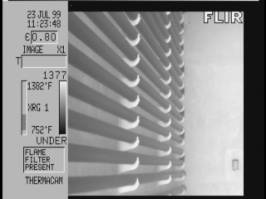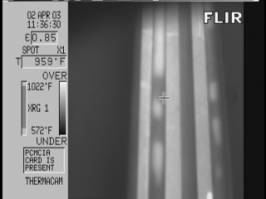IR Inspections of Furnace Tubes
Sponsored by:

IR Inspections of Furnace Tubes
Tip written by: Infraspection Institute
Process furnaces or heaters are a critical component found in many petrochemical refineries. Performed properly, infrared inspections of furnace tubes can provide valuable data regarding tube condition and operating temperature.
Process heaters are large, refractory-lined structures used to heat hydrocarbon product during refining. Process heaters are similar to steam boilers in their construction except that hydrocarbon is passed through the firebox tubes instead of water. Safe operation of process heaters requires that tubes operate below their maximum operating temperature. Overheating of tubes can reduce operational life or lead to catastrophic failure.
Measuring tube temperatures is difficult for many reasons. Tubes are often remotely located from inspection ports and are frequently obscured by visually opaque flames. High temperature environments make contact measurements difficult or impossible. Under the right circumstances, infrared thermography can be used to provide qualitative and quantitative data for in-service heater tubes. The following images were taken through viewports on operating heaters.

Image taken through opaque flame.

Image taken through opaque flame.
Infrared inspection of process furnaces or heaters is one of the most difficult tasks for thermal imaging and infrared radiometry. Accuracy in temperature measurement is of paramount importance since many companies utilize infrared data to determine safe operating limits for in-service heaters.
Far from being a “point and shoot” application, a thermographer needs to understand heater operation and heat transfer as well as issues pertinent to thermography. These include, but are not limited to: infrared camera selection including proper spectral response and spot measurement size; imager calibration; use of filters, windows and heat shields; calculating emittance and reflected temperature; equipment precision and accuracy; and how to obtain reliable reference temperatures to verify proper imager settings.
To help ensure accuracy, thermographers should be trained to at least Level II and, when possible, work with an experienced mentor until they have gained sufficient field experience.
Infrared inspection of process heater tubes is one of the applications covered in the Infraspection Institute Level II Certified Infrared Thermographer® training course. For more information or course schedules, visit us online at www.infraspection.com or call us at 609-239-4788.
More information on this subject is available via a free download from our website at: Applications of Infrared Thermography for Petrochemical Process Heaters.
Advertisement

